
Lythrum salicaria, or purple loosestrife, is a flowering plant belonging to the family Lythraceae. It should not be confused with other plants sharing the name loosestrife that are members of the family Primulaceae. Other names include spiked loosestrife and purple lythrum.
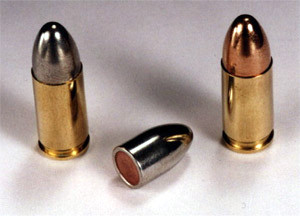
The 9×19mm Parabellum or 9mm Parabellum or 9mm Luger, is a firearms cartridge that was designed by Georg Luger and introduced in 1902 by the German weapons manufacturer Deutsche Waffen- und Munitionsfabriken (DWM) for its Luger semi-automatic pistol. For this reason, it is designated as the 9mm Luger by the Sporting Arms and Ammunition Manufacturers' Institute (SAAMI), and the 9 mm Luger by the Commission Internationale Permanente pour l'Epreuve des Armes à Feu Portatives (CIP). The name Parabellum is derived from the Latin motto of DWM, Si vis pacem, para bellum.

Shepherdia, commonly called buffaloberry or bullberry, is a genus of small shrubs in the Elaeagnaceae family. The plants are native to northern and western North America. They are non-legume nitrogen fixers.

The genus Coenobita contains 17 species of terrestrial hermit crabs.
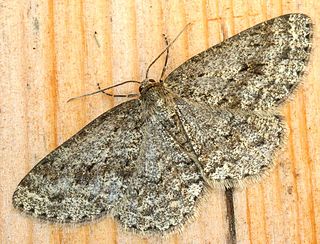
The engrailed and small engrailed are moths of the family Geometridae found from the British Isles through central and eastern Europe to the Russian Far East and Kazakhstan. The western Mediterranean and Asia Minor and the Caucasus represent the southern limit of the distribution. In the north, the distribution area ends at the Arctic circle. It also occurs in North America. Debate exists as to whether they make up one species, or whether E. crepuscularia actually refers only to the small engrailed, with the engrailed proper being separable as E. bistortata.
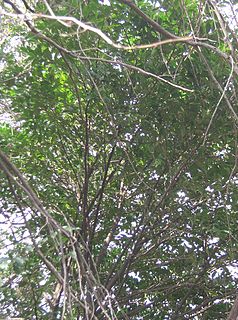
Eurya is a genus of about 70 species of flowering plants in the family Pentaphylacaceae.

The Boarmiini are a large tribe of geometer moths in the Ennominae subfamily.

Ectropis fractaria is a moth of the family Geometridae. It is found in Australia, including Tasmania.
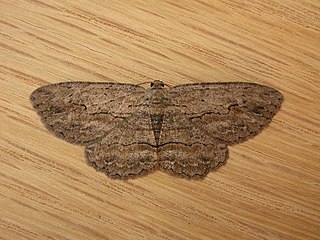
Ectropis excursaria, the twig looper, is a moth of the family Geometridae. It is found in the Eastern part of Australia.

Iflaviridae is a family of positive sense RNA viruses insect-infecting viruses. Some of the insects commonly infected by iflaviruses include aphids, leafhoppers, flies, bees, ants, silkworms and wasps. The name "Ifla" is derived from the name "Infectious flacherie virus", for the type species. There is only one genus (Iflavirus) and 15 species in this family, including the type species Infectious flacherie virus.

Ectropis is a genus in the geometer moth family (Geometridae). They are mostly paleotropical, but also plentiful in Australia and extend into Asia. Only one species – or cryptic species complex – is found in Europe. There are about 100 known species in this genus.
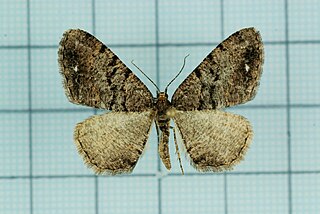
Parectropis is a genus in the geometer moth family (Geometridae). A small Old World genus, it contains only a good dozen species altogether, though new ones are still being discovered. Only one species is found in Europe; most others live in Asia though some occur in Africa.

Biston suppressaria, the tea looper, is a moth of the family Geometridae. It is found in China, India, Myanmar, Nepal, and Sri Lanka.
Ectropis distinctaria is a moth of the family Geometridae. It is found in Mauritius.
Alphabaculovirus is a genus of viruses in the family Baculoviridae. Its natural hosts are invertebrates, among them winged insects, and decapods. There are currently 55 species in the genus, including the type species Autographa californica multiple nucleopolyhedrovirus.
Ectropis obliqua is a species of moth in the family Geometridae first described by Prout in 1915.
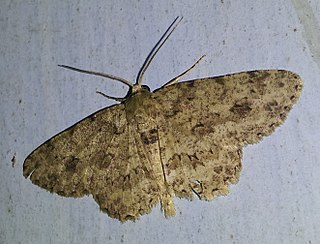
Ectropis bhurmitra, the tea twig caterpillar, is a moth of the family Geometridae. The species was first described by Francis Walker in 1860. A widespread Asian species, it is found around Indo-Australian tropics from India, Sri Lanka and Hong Kong, Taiwan, Thailand, New Guinea to Australian Queensland and the Solomon Islands.













